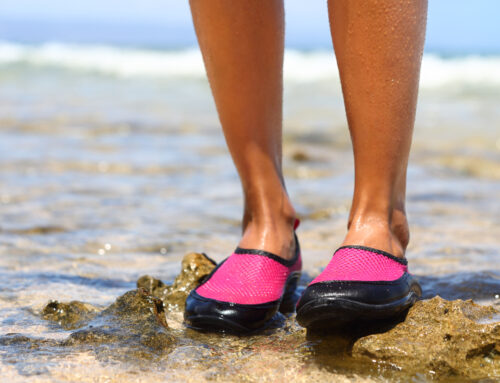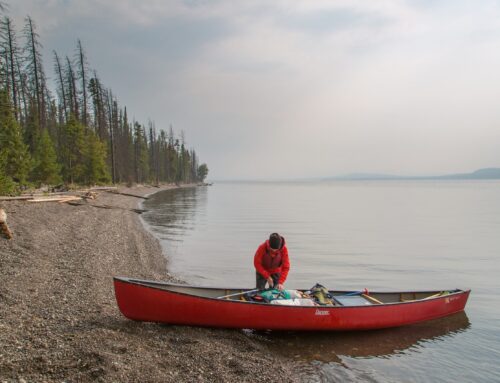Updated July 23, 2021
Surfing is an incredible activity you can try basically anywhere that has access to the ocean. While the sport itself is pretty straightforward, it’s easy to show up unprepared for big waves, strong currents, and sandy falls into the water. Wearing the right surfing clothes can improve your surfing experience tremendously, no matter where in the world you are. We created this guide to help you decide what to wear surfing, whether it’s your first time riding the waves or you’re a more experienced surfer who simply wants a refresher.
What to Wear Surfing: The Essentials
Swimsuit
It may be very obvious, but no list of what to wear surfing would be complete without a swimsuit. Certain types of swimsuits are better suited (haha, get it?!) for surfing than others. When surfing, you’ll fall into the water often, tumble in and out of waves, and you may need to deal with currents. This means that you’ll want to choose a solid swimsuit that can handle these kinds of conditions.
For women, we recommend a sturdy bikini or a one-piece swimsuit that won’t fall off. The last thing you want is to fall off your board…and realize your swimsuit has fallen off too. That’s why we’d suggest avoiding strapless swimsuits, tie-tops, or bandeaus for surfing, and instead opt for buckles or elastic swimsuits, which can hold up better in the ocean.
Either bikinis or one-piece suits can work on their own in warmer weather or fit easily under a wetsuit in cooler conditions. Some of our favorite brands for surf-friendly women’s swimwear include Summersalt, Billabong, Roxy, and PrAna.
For men, we recommend boardshorts for warmer conditions or a pair of surf undershorts underneath a wetsuit in colder conditions. Boardshorts will typically bunch up and can be uncomfortable under a wetsuit, so having rashguard undershorts or a Speedo-type swimsuit for use under your wetsuit can come in handy in colder weather.
Rip Curl, Quicksilver, and O’Neill have great options for men’s surf undershorts that will fit comfortably under a wetsuit.

Wetsuit
While not necessary in all surfing conditions, a wetsuit is a worthwhile investment for anyone who plans to surf often. Wetsuits are typically made of thick neoprene and come in a variety of sizes and colors.
A high-quality wetsuit should fit snugly and keep you warm as soon as you enter the water. It should be difficult to put on when dry and should hug your arms, legs, and torso without constricting movement. A wetsuit can also sometimes protect you from things that sting, like jellyfish.
Wetsuits come in different sizes and neoprene thickness (measured in millimeters). The thickness of your wetsuit will typically be determined by the temperature of the water where you’re planning to surf. The most common wetsuit thickness levels are:
- 5/4 – Wetsuits with a 5/4 designation have 5 mm of thickness on the torso and 4 mm of thickness on the arms and legs. These are generally used for colder conditions, such as the Pacific Northwest or New England in the off-season.
- 4/3 – A very common wetsuit thickness, wetsuits with a 4/3 designation have 4 mm of thickness on the torso and 3 mm of thickness on the arms and legs. These are usually worn in cool to cold conditions (58 to 68 degrees F).
- 3/2 – Another common wetsuit thickness, wetsuits with a 3/2 designation have 3 mm of thickness on the torso and 2 mm of thickness on the arms and legs. These are worn in mild to cool temperatures (68 to 78 degrees F).
- Springsuit or rash guard – In warmer temperatures, you may only need coverage on the top of your body. In these cases, a springsuit (a long-sleeved swimsuit) or rash guard (a long-sleeved swimming top to be worn with board shorts or over a women’s swimsuit) may be appropriate.
If you don’t think you’re ready to purchase a wetsuit yet, you can usually rent them at most surf shops near popular surfing areas.

Reef-Safe Sunscreen
Most people use sunscreen when they’re at the beach, but it can be easy to forget on cloudy days or foggy mornings. We recommend Sun Bum sunscreen for surfers because it’s reef safe and avoids chemicals that can harm marine wildlife. This is especially important when doing any water sports like surfing, SUP, and sea kayaking because certain sunscreen chemicals can harm coral reefs and other ocean animals.
What to Wear Surfing: Other Helpful Surfing Items & Clothes

Neoprene Booties
For cold and/or rocky surf conditions, a pair of surf booties is essential. These booties are typically made of neoprene and come in different sizes and configurations, including normal and split-toe designs. Our favorite style of booties is the split-toe design because they are much sturdier and stay firmly on your feet in rougher conditions. However, some may find these uncomfortable and opt for the normal, round toe options.

Surf Hood
Like booties, a surf hood can help keep surfers’ heads warm in cold water temperatures. These are also usually make of neoprene and come in a few different styles. While you won’t necessarily find hoods on many lists of what to wear surfing, they’re great for year-round surfers or those who typically surf in colder areas, like the Pacific Northwest or New England.

Neoprene Gloves
Another thermal accessory for any surfer is a pair of neoprene surf gloves, which are great for protecting your hands from cold water temperatures or sharp rocks. These often have rubber grips on the palms to make standing up on your board easier and slip-free. Gloves are often a necessity for surfers who typically ride in cold conditions, and can also be helpful in shallow areas with sharp rocks to avoid cuts and scratches on your hands.

Surfing Sunglasses
There’s nothing worse than catching a great wave and getting caught off balance because you were blinded by the sun. SeaSpecs Surf Sunglasses can help your favorite surfer avoid this situation! These polarized sunglasses are held on with a stretchy adjustable strap like swimming goggles, perfect for any water sports, including surfing.

Active Sandals
If you spend a lot of time on the beach, a solid pair of active sandals is a super useful gear item to keep with you. Many surfers opt for flip flops like these, but we prefer to use hiking sandals with ankle straps for all of our outdoor activities. We love Tevas and Chacos for any warm weather adventures, and we wear ours to the beach all the time.

Quick Dry Beach Towel
A lightweight, absorbent beach towel is crucial for trying off after surfing (because no one likes to be sandy and wet in the car!). One of our favorite brands for fun, lightweight beach towels is Slowtide. They’ve got tons of patterns across three different designs – beach towels, Turkish towels, and quick dry towels – which are perfect for surfers on the go. We personally love the Black Hills beach towel, but there are tons of different options to choose from.

Beach Changing Poncho
Any surfer knows how inconvenient it can be to change clothes in a vehicle, or to try and hunt down a public restroom for changing. With a beach changing poncho, you don’t have to! Changing clothes on the beach in privacy is easy and simple with one of these oversized garments, which provides protection and coverage while you’re getting out of your wetsuit into dry clothes (or vice versa).










